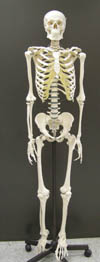Unit 2
Objectives
MAIN OBJECTIVES
The main objectives for Anatomy and Physiology are:
- To compare and contrast the various systems of the body.
- To identify the structures on models and specimens.
- To be able to discuss the functions of the systems and structures.
- To discuss the internal and external impacts on the human body.
- To show the interrelationship between structure and function of the entire organism.
Specific objectives for unit two:
- Bone Tissue
- Discuss the functions of bone. Identify the parts of the long bone.
- Describe the histological features of compact and spongy bone tissue.
- Classify the principal types of bones.
- Describe the process in bone remodeling.
- Describe a fracture, and the sequence of events involved in fracture repair.
- Describe the role of bone in calcium homeostasis.
- Describe the effects of aging on the skeletal system.
- The Axial Skeleton
- Describe the various types of markings on the surfaces of bones.
- Identify the bones of the skull and the major markings associated with each.
- Identify the principal sutures, fontanels, paranasal sinuses, and foramina of the skull.
- Identify the bones of the vertebral column and their markings.
- Identify the bones of the thorax and their markings.
- The Appendicular Skeleton
- Identify the bones of the pectoral girdle and their markings.
- Identify the bones of the upper extremity and their markings.
- Identify the bones of the pelvic girdle and their markings.
- Identify the bones of the lower extremity and their markings.
- Define the structural features and importance of the arches of the foot.
- Compare the major structural differences between male and female skeletons.
- Articulations
- Define an articulation and identify the factors that determine the types and degree of movement at a joint.
- Classify joints on the basis of structure and function.
- Contrast the structure, movement and location of the different joints.
- Describe the structure, types, and movements of freely moveable joints.
- Describe selected articulations of the body with respect to bones that enter into their formation, structural classification, and anatomical components.
- Describe the effects of aging on the joints.
Readings: Seeley's Anatomy and Physiology
Chapters 6, 7, 8
|

